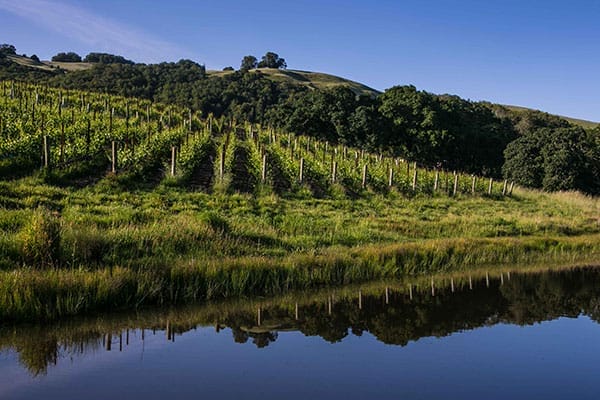Even the worms didn’t want to live in the dirt on the Sonoma County vineyard that Karissa Kruse, W’97, WG’04, purchased in 2008. Yet she still bought the 25 acres on top of Sonoma Mountain and named it “the nine’s vineyard.” This was part of the “wine country dream” that she and her business partner Justin Harmon, ENG’97, had envisioned to create a wine brand—Argot Wines (French for “slang”). This estate vineyard would become the backbone of the Argot Wine label and allow them to manage every aspect of the grape-growing and wine-making process. And, boy, did those worms have it wrong! Today, 2.5 acres are planted with syrah grapes, 2.5 more with pinot noir and another acre with chardonnay. Overall, they are producing around 3,000 cases annually, from the estate fruit and other sought-after vineyards around Sonoma County.
It was back in fall 2012 that we first spotlighted Wharton’s winemakers—see “Uncorking a Dream Business”—and we missed Kruse on that pass.
But we caught her on this one—as she passed through campus, talking with students and meeting staff —and decided to spotlight her efforts—not so much for her viticulture as much as for her drive to transform how the whole of Sonoma makes wine. As president of the Sonoma County Winegrape Commission (the “Sonoma County Winegrowers”), Kruse is helping to make Sonoma County America’s first 100 percent sustainable wine region by 2019.
She and her association of vineyard owners and their winemaker partners formally announced the initiative on Jan. 15, 2014—after which it “exploded” through the wine world, she said—but it’s actually an idea first broached by one of her Winegrower members, Duff Bevill. Through an email and subsequent lunch, he asked her how they could become leaders in sustainability.
Her answer: “There’s only one way to be a leader in sustainability, and that’s to do it,” she told him.

Karissa Kruse, W’97, WG’04
Easier said than done in Kruse’s case.
In 2012, with Argot as her side business, she was a consultant who traveled all of the time. An opportunity for change beckoned when a position for director of marketing popped open at the Sonoma County Winegrowers. And here is the sweet part: At the time, the Winegrowers president was planning to retire, which created an opportunity for Kruse to demonstrate her value and seek the promotion. Six months later, she achieved just that. As president, she heads a board of 17 men and 3 women—all essentially multigenerational family farmers.
And she, a 38-year old, decided to convince them that sustainability is the way to go. You can imagine the responses to this fresh blood coming into their midst—farmers fearful of changing techniques they have used for generations. Isn’t “sustainability” just a catchy phrase? What real-world benefit could come of it?
Her case is strong, though. Her point? She isn’t asking the 1,800 members to revolutionize how they farm—she’s just asking that they strengthen their current practices to better protect their land and their businesses. It’s about having a healthy farm to pass on to the next generation for the 85 percent of Sonoma winegrowers that are family businesses. It’s about meeting consumer and retailer demand for greener products.
“It’s like getting a Ph.D. in your vineyard,” is how one Sonoma County Winegrower member described it to Kruse.
And as a winery owner, Kruse said, “I’m not asking them to do something I am not doing myself.”
Kruse’s model is based on the Sustainable Winegrowing Program from the San Francisco-based Wine Institute, a triple-bottom-line approach. The first step is to train and educate winegrowers on more than 100 best management practices, and to collect data on more than 15,000 vineyard acres per year for four years (until all 59,000 acres operated by Sonoma County Winegrowers members are covered).
The second phase will involve individual winegrowers getting certified. It’s not to say that other wine-growing regions do not possess sustainable business—how long has Burgundy been producing wine?—but making it a formal process is a big step, Kruse stressed.
“We haven’t seen anyone else put a similar stake in the ground,” she said.
In this case, that stake is covered with pinot grapes.


























